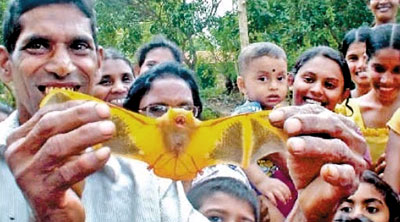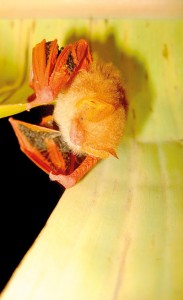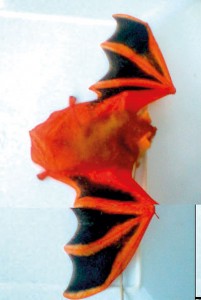News
Curious humans take upside down view of orange-hued flyer

Beauty becomes a curse – a painted bat becomes a public attraction in Eppawala, Madiyawa 2012 (c) Internet
An attractive bat that is rearely seen, is best left alone if you find one hanging from a tree in your garden, researchers have appealed following media reports that have generated a buzz.
This week, news reports said an orange colored bat had been sighted in Thalgaswewa, Kanthale at a corn farm by its owner. After a three-hour struggle, the creature had been captured, the reports added. Amused villagers gathered en masse to take a look at the unusal specimen.
“This is not a new species, but a painted bat, scientifically categorized as kerivoula picta. It is a beautiful bat with a body color of bright orange with black wings and orange along the fingers. They also possess long, wooly, rather curly hair,” bat researcher Prof Vipula Yapa of the University Colombo said. The painted bat is a small creature with body length of between three centimetres and 5.5 cm. It feeds on insects.
“This bat can be found mostly in the low country dry zone – specially in areas such as Udawalawe and Embilipitiya, where there are banana plantations. During the day time, these bats hide among withered banana leaves,” says another bat researcher Gayan Edirisinghe. “Because the painted bat is mostly associated with banana plantations, it is also known as by the Sinhala name ‘visithuru kesel wavula’.
The painted bat usually flies out of its hiding place as dusk falls to begin hunting for food. They may often visit home gardens, but because people are not observant, they rarely notice the bat. But when they see it, this often leads to attempts to capture the creature in the mistaken belief it is a new species. Usually, it leads to the death of the creature.
The Kanthale bat found this week had been due to be handed over to the Department of Wildlife Conservation office in Kanthale. But when the Sunday Times contacted the office, no one had not heard of it.
“The painted bat is not that common, but they should be left alone. People should not try to catch them. Handling them badly can lead to death,” bat researchers plead. “It is also illegal to catch them.”
The painted bat is categorized as ‘near threatened’ by the Red List 2012. Sri Lanka is home to 30 different bat species. Nearly 20 of them feed on insects. These bats help to control the insect population.

Painted Bat (Kerivoula picta) in its ideal habitat (c) Gayan Edirisinghe.

A painted bat struck by a vehicle on the Kanthale to Trinco stretch in 2011 (c) Devsiri Peiris

